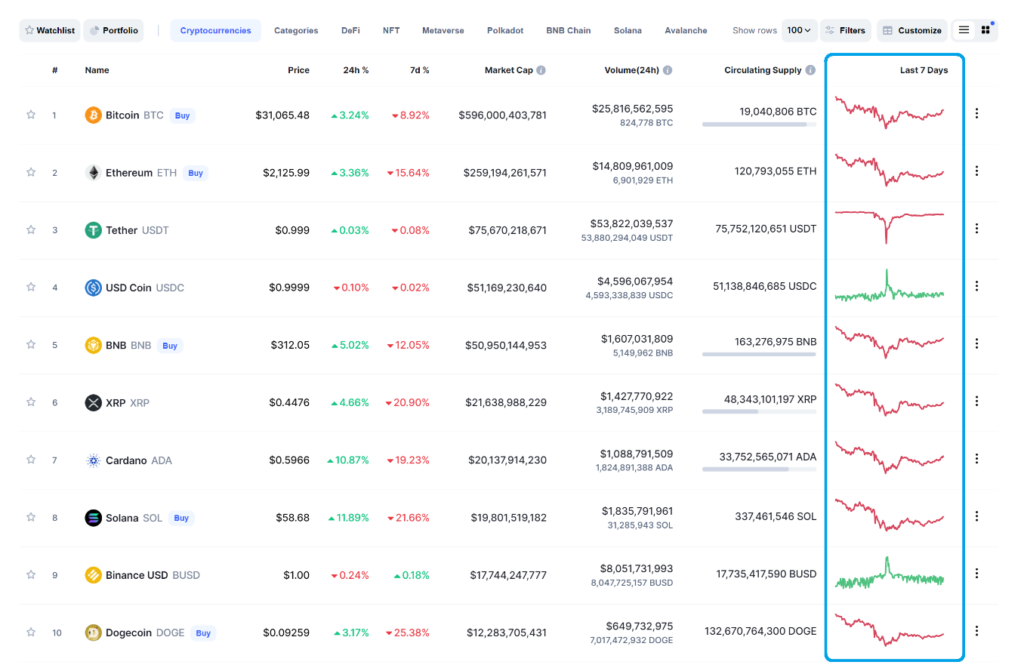In 2022 we saw the Coinbase Super Bowl commercial and were immediately intrigued. After all, your coworkers have boasted about their massive Bitcoin and altcoin bags that beat the S&P 500 over the past few years. You’ve had enough and don’t want to be left out. After signing up on an exchange, you see hundreds of coins to choose from. You’ve heard of Bitcoin and Ethereum but have never heard of any of the others. Investing in cryptocurrencies requires research and a decent understanding of each project’s purpose. The value of each coin or token is derived from a project’s intended utility and the expected returns on investments are correlated with its respective category. Be careful because there are a lot of crypto scams, potential scams, pump and dump and Ponzi schemes, use this guide to do your research.
It sounds like a good idea to invest in several coins to ‘diversify’ your portfolio, right? Well, not so fast! Blindly investing in coins is not the smart or right way to go and that’s why we created a guide on how to apply fundamental analysis to crypto investments here. We’re also going to do you another solid by helping you to differentiate the various types of cryptocurrencies out there. Trust me, you’re going to want to know the different cryptocurrency categories because your return on investments will depend on it!
Why You Should Care
Investing in cryptocurrencies requires a lot of research and a decent understanding of each project’s purpose. The value of each coin or token is derived from a project’s intended utility and the expected returns on investments are correlated with its respective category. To illustrate our point let’s take a look at some of the top cryptocurrencies by market cap: Bitcoin and Ethereum.
Bitcoin has steadily been increasing in price since its inception back in 2009 and in 2022 hovers at $31,000 per BTC. Ethereum was created shortly thereafter in 2014 but has remained more or less pegged to Bitcoin since then and its price similarly has increased in the macro uptrend. Ether’s price was around $2100 in 2022 but if you take a look at both price charts, you will see that the price action and movement of Ether mirror that of Bitcoin. In fact, most cryptocurrencies follow Bitcoin’s price action.

Source: CoinMarketCap
Bitcoin and Ethereum, however, were built for entirely different purposes. Just because the price charts look similar doesn’t mean they should be viewed as similar cryptocurrencies. Bitcoin is a store of wealth and Ethereum is a smart contract ecosystem. They are both cryptocurrencies but the way people invest and interact with them are different because of their utilitarian differences.
Bitcoin maximalists will say there is no better long-term crypto investment than BTC but supporters of Ethereum believe in a decentralized digital ecosystem that will power global economies. No one knows which project will outlive the other but one thing savvy crypto investors will agree on is that when choosing cryptocurrencies to invest in, we must investigate their real-world purpose and the potential value created from the utility. To do this the first step is to understand what type of category the cryptocurrency is in.
Cryptocurrency Categories
Over 10,000 cryptocurrencies are listed on CoinMarketCap and they all have different project intents and utilities. Don’t be fooled – just because a cryptocurrency is in the top 10 list doesn’t mean they are necessarily sound investments. If you bought $1000 worth of Tether (USDT) a year ago, your bag’s value would have stayed the same and that’s because it is a stablecoin. If you bought $1000 worth of Dogecoin a year ago that same investment would be worth roughly $500 now and that’s an expected outcome from a downward trending meme coin. Make sure you understand the following 8 cryptocurrency categories so you know what you’re putting your hard-earned cash into.
1. Store Of Value
Bitcoin (BTC) was originally designed to be a digital currency but it has evolved to become the only true store of value asset. Though the asset frequently experiences wild volatility, pundits generally agree that out of all the cryptocurrencies, Bitcoin’s dominance, economic confidence, and public perception enable it to increase its purchasing power over time. As with physical gold, Bitcoin is also scarce which contributes to its perceived value and price.
Investors will look at Ethereum and other notable altcoins as a store of value but seeing how institutions, corporations, and governments turn mostly to Bitcoin to HODL, we can say with confidence that Bitcoin is, without a doubt, digital gold. If you are looking to buy and hold, look no further because Bitcoin is your best bet.
2. Payment Currencies
Bitcoin failed to become the de facto digital currency that it was intended to be due to high transaction fees, slow transactions, instability with price, and the lack of true anonymity. As expected, spinoffs were created that addressed Bitcoin’s pitfalls. Coins like XRP, Litecoin, Bitcoin Cash, Stellar, and Dash swiftly replaced Bitcoin as viable mediums of exchange that enable users to make everyday purchases or near-instant bank transfers cross-border.
Should you invest in digital currencies? It depends if you’re actually going to use them for their intended purpose or if you’re going to HODL. These days, businesses will accept cryptocurrencies from various categories as a form of payment and they aren’t necessarily in the digital currency category (ie. Bitcoin, Ethereum, Dogecoin, Shiba Inu, etc.). Some of these coins will have a stronger purchasing power in the future than purpose-built payment currencies but you’ll need to be patient because transactions are typically slower (ie. Bitcoin, Ethereum).
3. Blockchain Economies
Blockchain ecosystems are built on smart contracts and dApps. Ethereum was the first to create a successful smart contract-powered blockchain and dApp-based ecosystem. At 64% of all total value locked (TVL), Ethereum’s $70 billion dominance in the DeFi space draws competitors that are competing for a slice of the TVL pie. Competition is stiff but the most notable ones include Cardano, Polkadot, Avalanche, Solana, Algorand, and Polygon.
After Bitcoin, as a store of value, smart contract-based blockchains are your next best bet for crypto investing. The reason for this is simple: utility. These crypto projects were created so that ecosystems could exist. Some real-world applications include decentralized banking, gaming, insurance, supply chain, and cyber-security. Because these projects were created with the big picture in mind, you can expect that developers will continuously work towards improving the ecosystems they are working on. Smart contract projects and their respective cryptocurrencies generate tons of cash flow for the project and ecosystem and will likely have sustained or increasing value over time.

Source: DeFi Llama
4. Stablecoins
Stablecoins are alternative cryptocurrencies that aim to provide their users with a stable, non-volatile, medium of exchange. These coins maintain a peg of their value to some reference like the dollar or gold so that the price remains stable. In theory, notable stablecoins such as Tether, USD Coin, Dai, and Binance USD will always have a price of $1 per coin, but do your research because some of these are not $1 to $1.
Why is it important for stablecoins to remain stable? Imagine spending some Bitcoin to purchase a good or service one month but the next month the price tanks. Now it takes more Bitcoin to pay for the same thing due to the price drop. Paying with stablecoins means transactions are more predictable as the value of the coin remains relatively stable similar to fiat. It’s no wonder that stablecoins are frequently used on exchanges for trading and general banking. Late 2022 and 2023 proved that stablecoins aren’t that stable.
5. Exchange Tokens
Exchange tokens are native to centralized or decentralized cryptocurrency exchanges. Typically they are created to generate revenue, incentivize trades, increase liquidity, or facilitate a governance process within the exchange. Because exchange tokens were designed to help build out the exchange’s ecosystem, using them for payments in the real world is rare. Some exchange tokens hold value and some even increase in price over time but that is largely dependent on the popularity and customer base of the exchange.
Binance Coin is a well-known exchange token along with Uniswap, Sushiswap, FTX Token, Curve DAO Token, and PancakeSwap. Exchange tokens aren’t typically bought for HODLing since they have more of an exchange and DeFi-focused application. Thus, exchange tokens are better suited for active traders and investors.
6. NFT/Metaverse
NFT and metaverse tokens are typically associated with the project’s currency model, digital art marketplace, or technology that helps to sustain or advance the business model. These tokens can represent a virtual reality platform (Decentraland, MANA), a utility and governance token (ApeCoin, APE), in-game currency (The Sandbox, SAND), gaming experience points (Axie Infinity, SLP), or layer-2 scaling solution for Ethereum based NFTs (Immutable X, IMX). Investing in NFT or metaverse tokens means you have faith in the game, metaverse, and ecosystem that the token’s project represents.
7. DeFi
Decentralized finance is the largest sector in blockchain and for good reason. DeFi protocols were created solely to generate revenue for the project team and customers through lending, banking, trading, arbitrage, and yield farming. Investing in DeFi tokens such as Aave and Maker means you get to enjoy discounted transaction fees on its platform. They also serve as governance tokens that enable users to vote on project changes or allocation of funds. Other notable DeFi projects include Compound, Celsius, yearn.finance, and Nexo.
The DeFi market is crowded, and new projects are always being created due to the potentially lucrative opportunities that come with it. Be wary and do your due diligence with DeFi-based tokens because when you hear of scams in the news, they’re likely talking about a DeFi scam. Stick to the reputable projects that have been around for a while.
8. Meme Coins
Meme coins are a joke – literally. At least, that was their intended purpose. The two best-known meme coins include Dogecoin and Shiba Inu and they both sport a dog-themed mascot as the face of their respective projects. Meme coins will usually have fun and light-hearted branding which is meant to draw attention, inspire ideas, or simply make fun of existing memes. Additional meme coins include Doge Dash, Dogelon Mars, and Samoyedcoin.
Investing in meme coins is typically not a good idea for long-term HODLing. However, millionaires have been minted via meme coin investments but they were largely due to sudden surges in prices. Because pump and dumps are common, along with their supply being typically uncapped, you would be closer to gambling than investing when it comes to meme coins. Steer clear on any coin that doesn’t have a doxed team or solid roadmap of useful and impactful project milestones.
Navigate The Cryptosphere With Confidence
Now that you have a general idea of what’s out there, go ahead and research each project with confidence. As you learned, some cryptocurrencies are better suited for safe long-term HODLing, while others should be approached with caution or not at all. Each cryptocurrency was created for a different purpose, and they aren’t all meant to generate profits. Whichever cryptocurrency you buy, make sure you understand the project’s vision and believe in what they are doing. This post was written by Ironsung on Fiverr. I hire Fiverr writers to write on topics they are proficient in; this way we can all learn more. For more from Ironsung Top 3 Cryptocurrencies that you should buy in 2022 and How NFTs are used in the Supply Chain. Enter your e-mail address into the subscribe box so that you can keep up with new business, sales, and investing posts. Have a lovely day.
Disclaimer
I want to make it unequivocally clear that I do not promote any cryptocurrency, nor do I endorse any crypto investments. This website is dedicated to providing information and insights into the world of cryptocurrencies to help you better understand what crypto is. If you ever find yourself in a position where you need to explain your decision not to invest in cryptocurrencies to friends or acquaintances, you can use the content on this site as a guide to discourage people from falling victim to scams or making hasty financial decisions. My ultimate goal is to empower individuals with knowledge and awareness so that fewer people become financial victims. Life is already challenging with its inherent obstacles; we don’t need the added burden of unscrupulous individuals looking to exploit our hard-earned money. Stay vigilant, stay informed, and make financial decisions with caution. Your financial well-being is of paramount importance, and it is my sincere hope that the information here can assist you in making prudent choices.











